Now i am getting ideas for next years chainless. Most canoes are tandem correct?Nothing wins downhill quite like a slippery upside-down canoe.
- COMPETITIONS
- THE COMPETITION ARCHIVES
- THEME BUILD OFFS
- WINTER 2017 BUILD OFF - ANYTHING GOES!
- WBO 2017 BIKES
You are using an out of date browser. It may not display this or other websites correctly.
You should upgrade or use an alternative browser.
You should upgrade or use an alternative browser.
Mint Chocolate Chip-A bike built for the Crested Butte Chainless World Champs (Finished)
- Thread starter squirreldh
- Start date

Help Support Rat Rod Bikes Bicycle Forum:
This site may earn a commission from merchant affiliate
links, including eBay, Amazon, and others.
Scary high in more ways than one! I'd feel better with a low center of gravity stance!A friend did it on a pennyfarthing a few yers back... no chain! Of course he wasn't the most competitive, but this is a fun event as opposed to serious competition, I am just going for glory
5 days!How much time is left?
I know, have not had time! Was watching a friends place in downtown Denver last week, and its springtime, lots more work coming into the shop these days, hard to get work done on the ride!
Sent from my SM-G550T1 using Tapatalk
Sent from my SM-G550T1 using Tapatalk
Pretty much have accepted defeat, and I am okay with that. Doubtful this project will be completed before April 1st, but I will be continuing the project! The event it is being built for happens in June, so I have plenty of time to complete it before the race, but not before the end of the build off  I have enjoyed my first one, glad I was able to submit one completed ride!
I have enjoyed my first one, glad I was able to submit one completed ride!
Sent from my SM-G550T1 using Tapatalk
Sent from my SM-G550T1 using Tapatalk
Pretty much have accepted defeat, and I am okay with that
That sucks, but eagerly looking forward to the race update!!!!!!

$249.40
$289.67
Kulana Lakona Tide Adult Beach Cruiser Bike, 26-Inch Wheels, 7-Speed, Silver
Amazon.com

$18.99
Old River Outdoors Bicycle/Motorcycle Chain Picture Frame 4" X 6" Photo - Faux Bike Chain
Old River Outdoors (USA Merchant)

$99.99
$108.99
Schwinn Toggle Quick Build Kids Bike, 12-Inch Wheels, Smart Start Steel Frame, Easy Tool-Free Assembly, Blue
easiness

$19.99
Electra Glide Wall Decal 2ft Long Sport Harley Davidson Bike Motorcylce Sticker Man Cave Garage Boys Room Decor
FatCat Wall Graphics

$199.99
$229.99
Huffy Stone Mountain Women's Mountain Bike, Gray, 26 Inch Wheels/17 Inch Frame
HuffyDirect
You know what, there is over 39 hours left on the countdown clock.... I dont think I am ready to throw in the towel just yet...
Sent from my SM-G550T1 using Tapatalk
Sent from my SM-G550T1 using Tapatalk
I want to be able to add weight, so I found a hardened steel through axle for a DH bike and attached weights to the BB. Was able to get 30lbs on there. Took it out for a couple quick test runs.
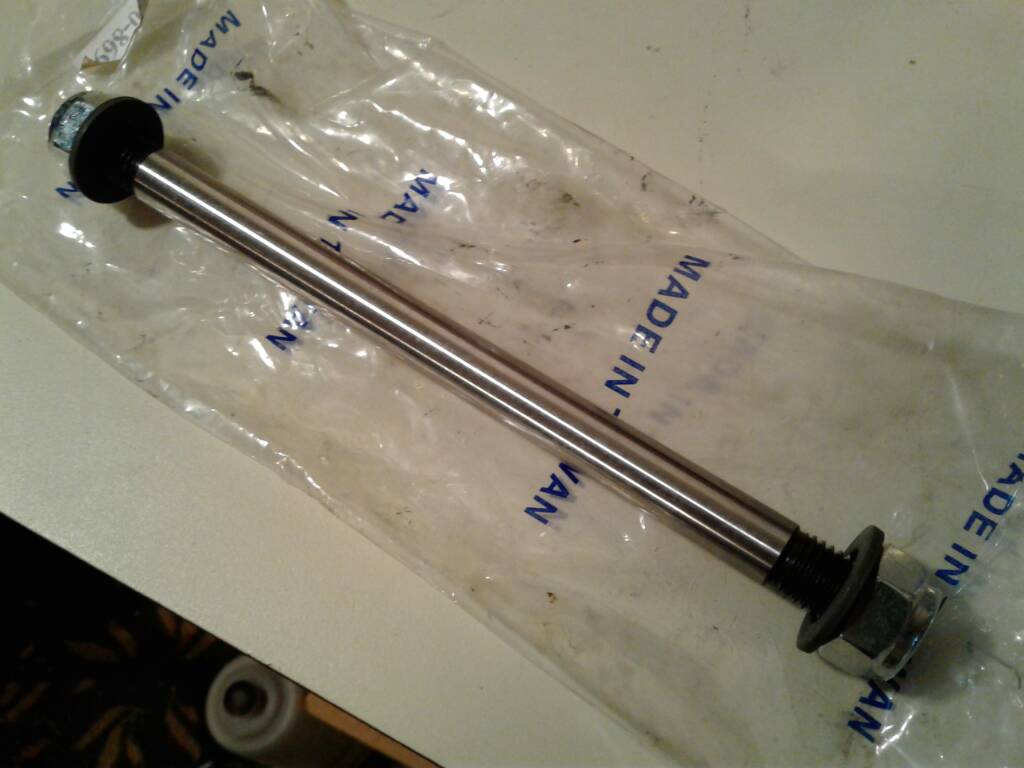
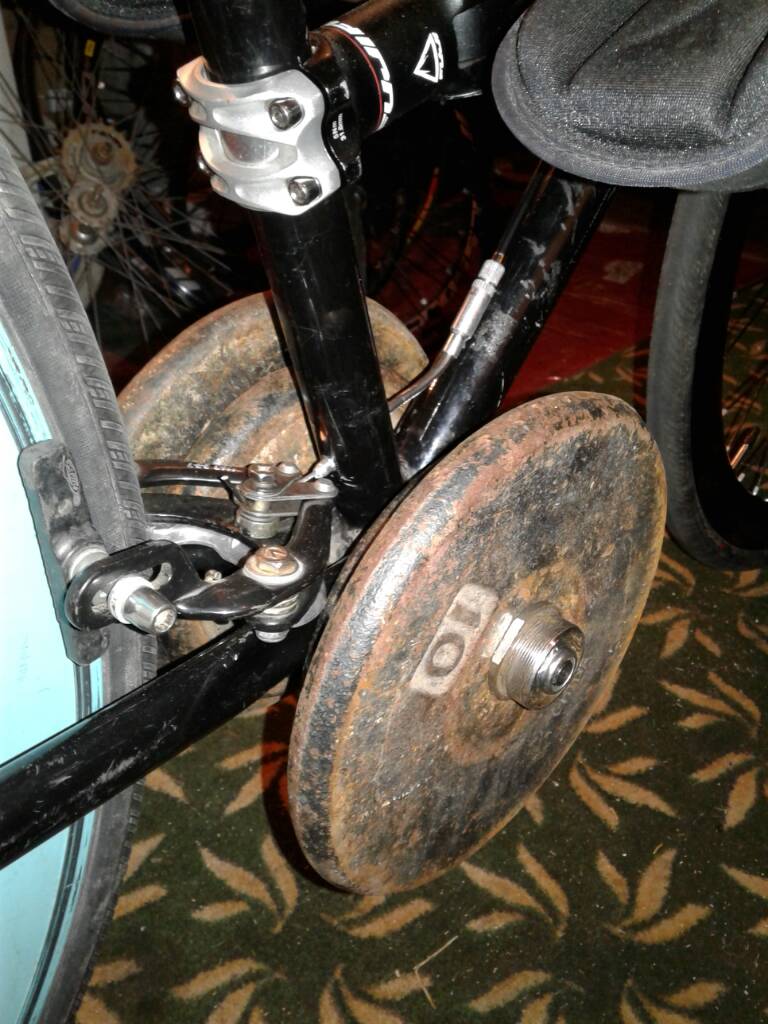
This is the hill I am testing on, doesnt look like much, but there is a slight descent there.
From the bottom

From the top
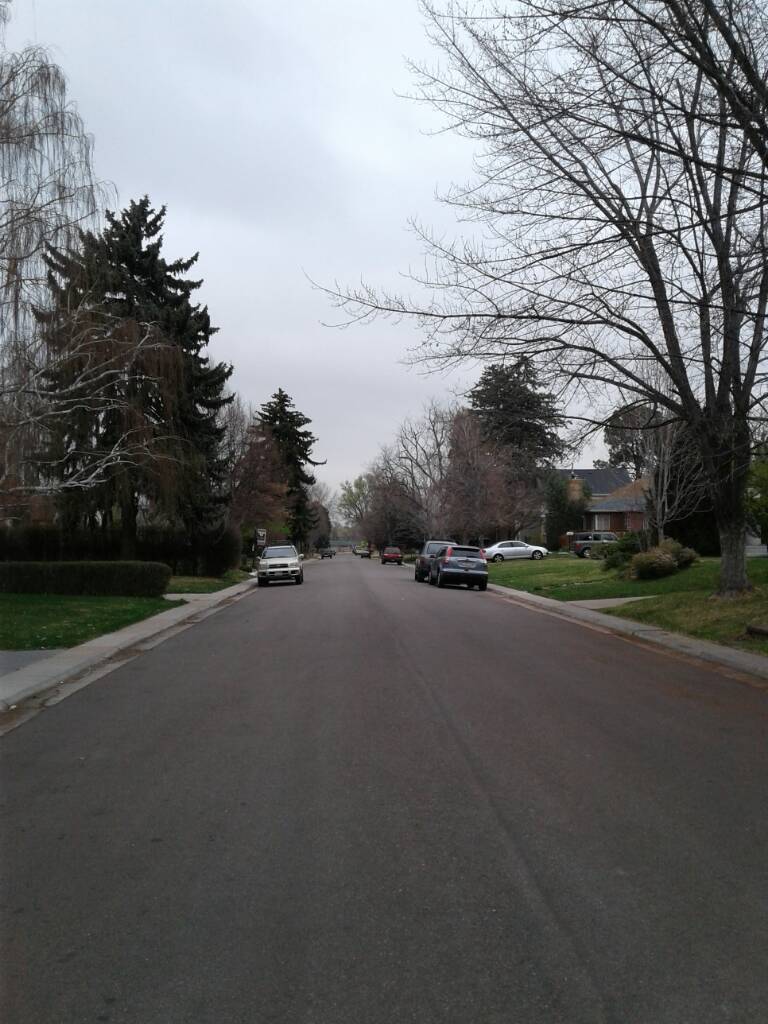
Wondering if the headwind is making a difference in speeds as with the weight I was slower than without. Must do more tests!
I really want to get a fairing made, without doing that I cant call this build complete.


This is the hill I am testing on, doesnt look like much, but there is a slight descent there.
From the bottom

From the top

Wondering if the headwind is making a difference in speeds as with the weight I was slower than without. Must do more tests!
I really want to get a fairing made, without doing that I cant call this build complete.
As a long-time gravity racer, I've found that off of a standing start, and on hills with minor grades (4-5%), the lighter vehicles tend to roll out better/faster. Where the weight really makes the difference is on steeper grades, and when speeds get higher. Around 35-45 mph (airspeed) seems to be the point when aerodynamics (or lack thereof) really starts making a difference, and the higher the weight, the higher the terminal velocity for a given grade is going to be. Basically, the weight just moves the threshold up finding the point when the frictional forces find equilibrium with the effect of gravity on the vehicle/rider.I want to be able to add weight, so I found a hardened steel through axle for a DH bike and attached weights to the BB. Was able to get 30lbs on there. Took it out for a couple quick test runs.
Wondering if the headwind is making a difference in speeds as with the weight I was slower than without. Must do more tests!
I really want to get a fairing made, without doing that I cant call this build complete.
Our mantra was, "Weight is nature's turbocharger." It doesn't necessarily get you out of the hole any faster, but on the top end, once you're "on boost", it can make quite a difference.
Thats what I have been thinking. The weight, while slower to accelerate on a lesser grade will eventually top out at a higher speed.
Looking at the elevation profile for the descent, right out the gate the hill hits about a 7% grade. I noticed last year with 35lbs on my back I was passing people on that first section and keeping up with most of the pack for the entirety of the descent. There was a section midway with less grade, I felt slower through there, though that may have been due to my body positioning on my Higgins, I wasnt the most aero.
Speed on the descent, even for the fastest guys on road bikes, pedalling down the mountain, are only in the high 30s, barely 40mph. So I doubt I will be attaining such speeds with the pedal assist. Will a fairing even be necessary?
I think I want to come up with a different mount for the weights, something I can quickly swap weights with. And do some testing on the actual course the day before with different amounts of weight to determine which is best for that particular course. I really dont like the way they are on there now.
Sent from my SM-G550T1 using Tapatalk
Looking at the elevation profile for the descent, right out the gate the hill hits about a 7% grade. I noticed last year with 35lbs on my back I was passing people on that first section and keeping up with most of the pack for the entirety of the descent. There was a section midway with less grade, I felt slower through there, though that may have been due to my body positioning on my Higgins, I wasnt the most aero.
Speed on the descent, even for the fastest guys on road bikes, pedalling down the mountain, are only in the high 30s, barely 40mph. So I doubt I will be attaining such speeds with the pedal assist. Will a fairing even be necessary?
I think I want to come up with a different mount for the weights, something I can quickly swap weights with. And do some testing on the actual course the day before with different amounts of weight to determine which is best for that particular course. I really dont like the way they are on there now.
Sent from my SM-G550T1 using Tapatalk
The other thing that you may want to consider is going up a tire size or two if you're packing extra weight. Narrow tires tend to squirm, deflecting laterally, in the corners when subjected to excess loads. This can negatively affect not only handling but increase drag quite a bit as well. That is to say: A 21mm tire that rolls great under a 150 lb rider will often have a higher rolling resistance than a 28mm tire when subjected to a 220 lb rider at he same pressure. Since tires are designed for a certain amount of radial squish, upping the pressure to try to combat lateral squirm during cornering can make the tire too hard to grip well in the corners, and also can negatively affect rolling resistance.
Edit: Touring riders don't just use 32-43mm tires for a cushier ride, but because they actually roll easier than skinny tires when you start piling the weight on.
Edit: Touring riders don't just use 32-43mm tires for a cushier ride, but because they actually roll easier than skinny tires when you start piling the weight on.
That is another condideration I have had. Rolling a 25c now, think I may be able to go up to a 38c. More surface area to distribute the load means less rolling resistance. As far as cornering, there really isnt much, if any. The descent is fairly straight, and the curves there can be straigtened out by clipping the apexes.
Sent from my SM-G550T1 using Tapatalk
Sent from my SM-G550T1 using Tapatalk
Decided to install a small saddle on it. Not so much for sitting on, but to help prevent contact with the rear wheel, and provide a small amount of padding between me and the bike.
Started by mounting the top of an old seatpost to the brake arch
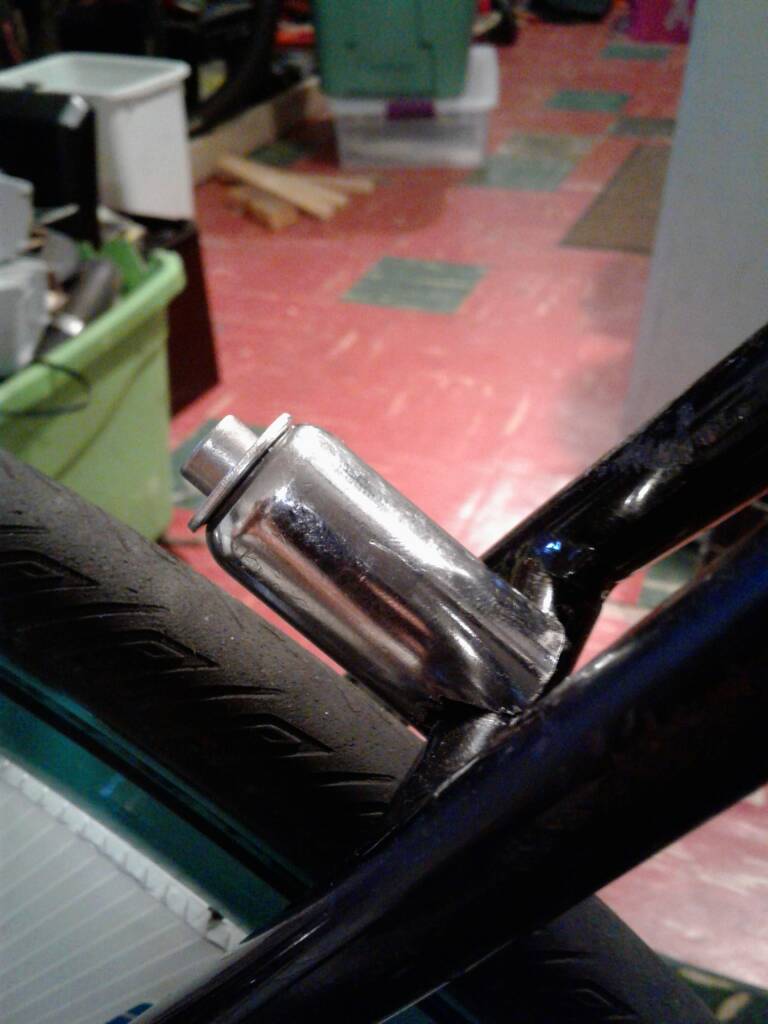
And then used a tradtional seatclamp to attach the saddle
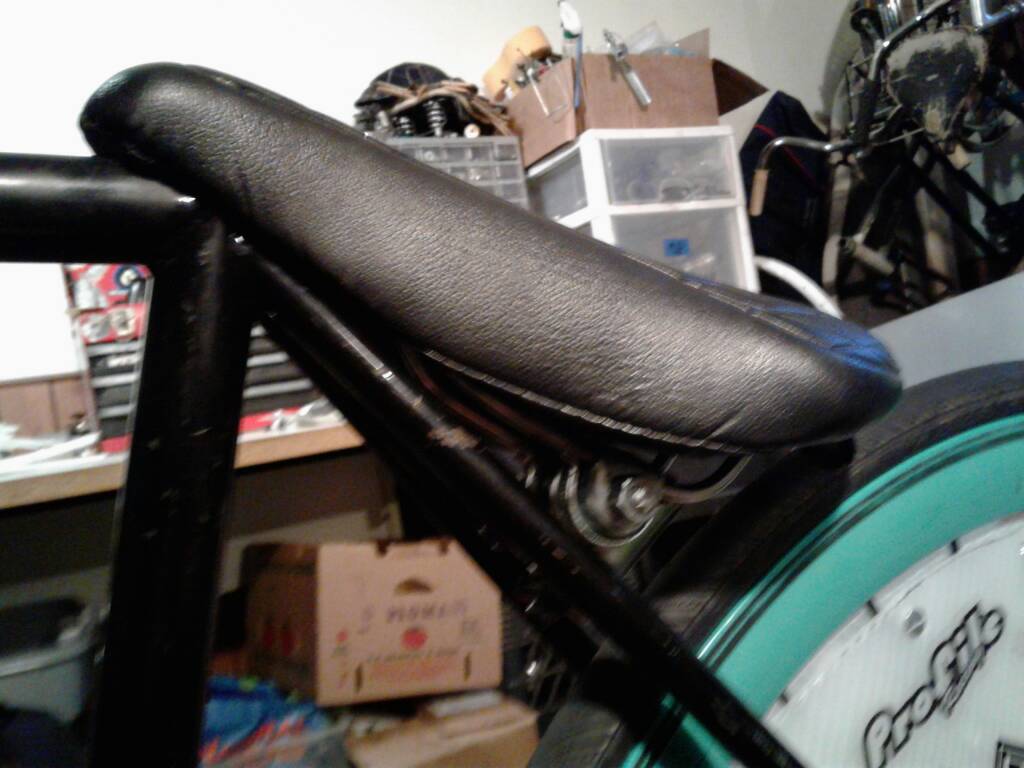
Started by mounting the top of an old seatpost to the brake arch

And then used a tradtional seatclamp to attach the saddle

Tapatalk just updated and I do not like it! I had to go back and edit that post to get the text between pics, cannot imagine having to do that to a pic heavy post. This update sucks!
Sent from my SM-G550T1 using Tapatalk
Sent from my SM-G550T1 using Tapatalk
So I played around with the weights a little. I now have 40lbs mounted! The bar I have that normally holds them is a little long and too large in diameter to fit the bottom bracket shell, reason for the steel axle instead. Changing them out should prove fairly easy, and allow me to go from 20lbs up to 40lbs in 5lb increments depending on which combination of weights I use. Not sure if anyone noticed but those are old drive side bottom bracket cups capturing the nuts. Also decided to use these classic metal clips for the brake cables, which may come off if I decide to cover the open space of the bike.
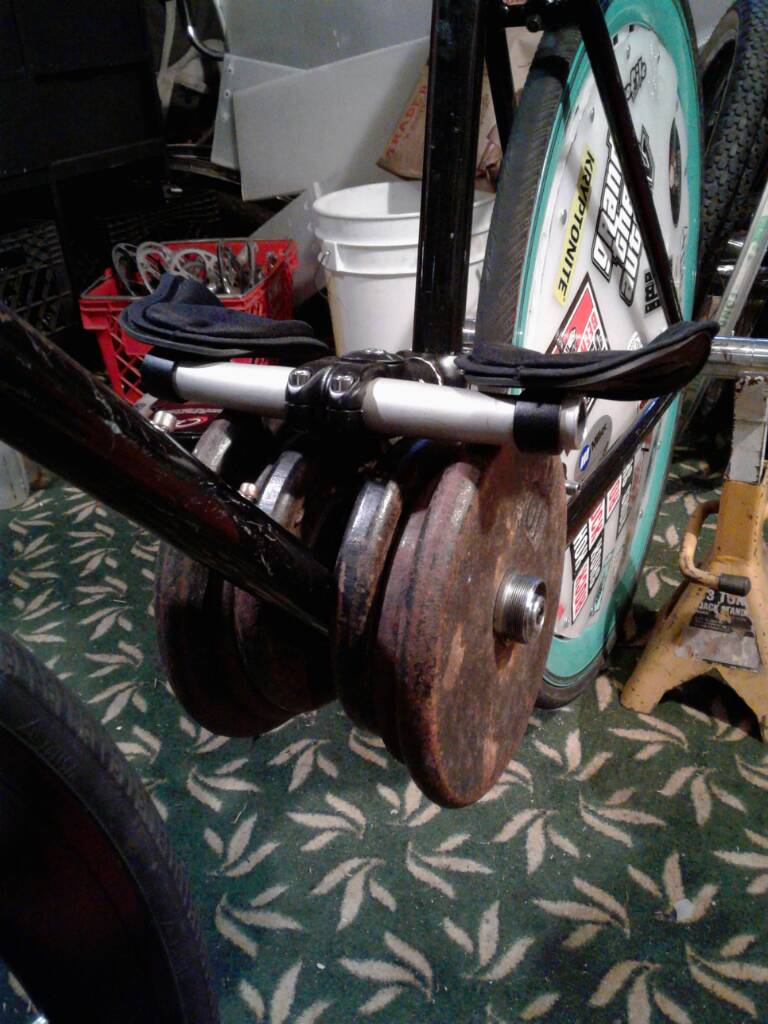
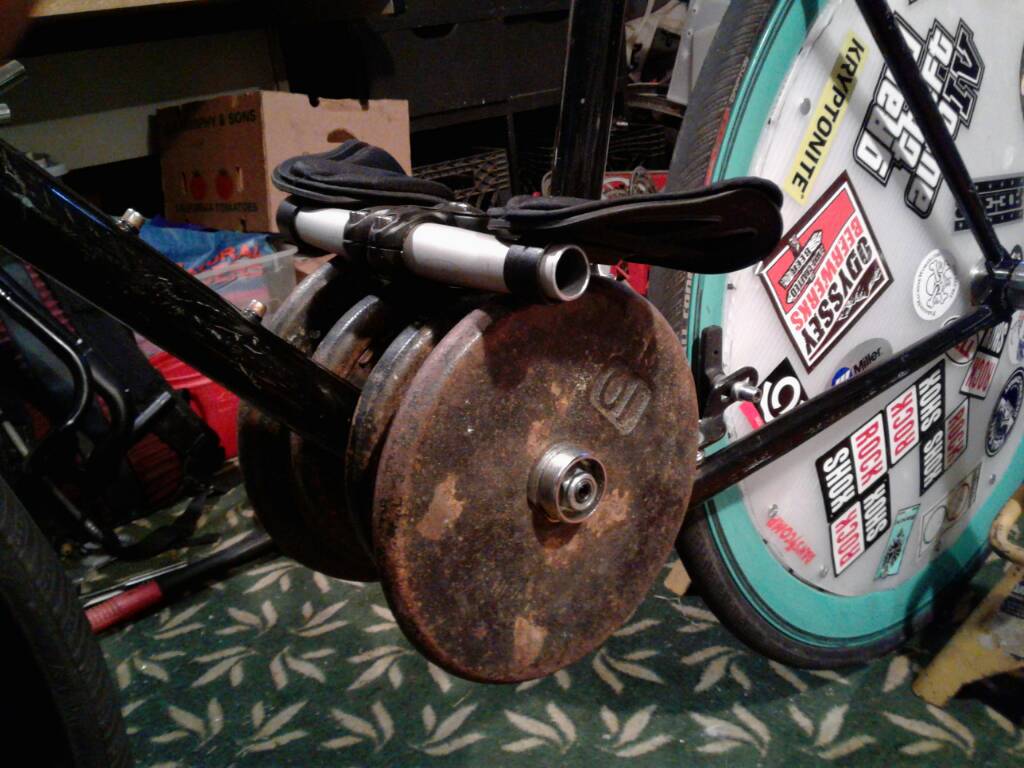
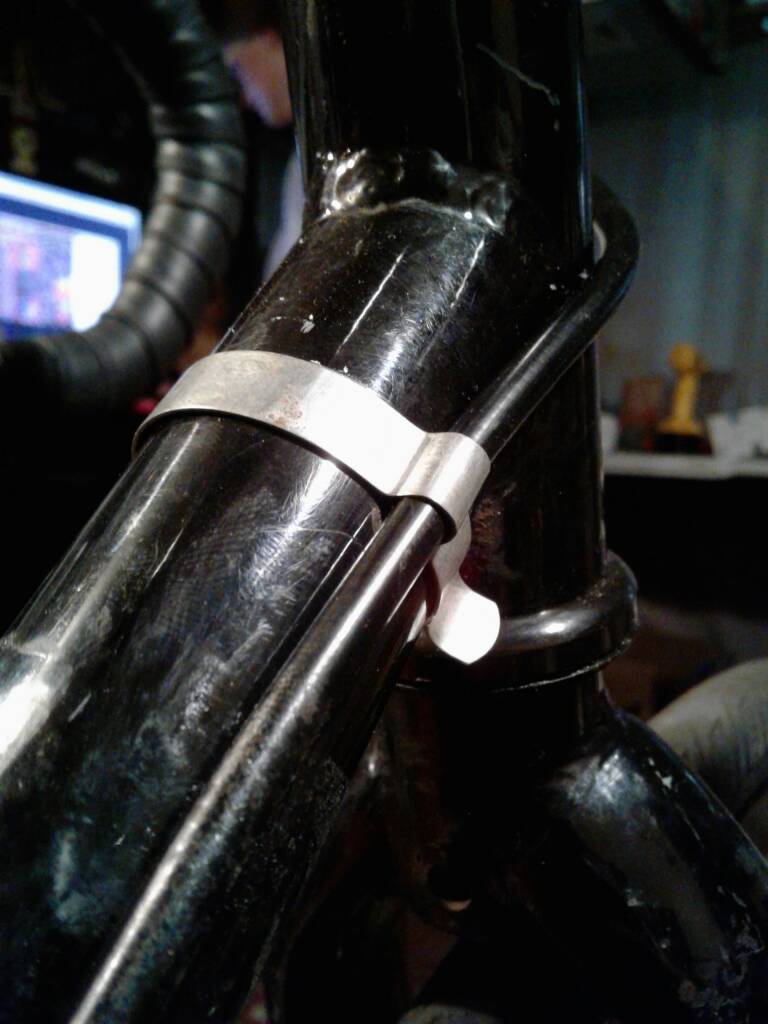
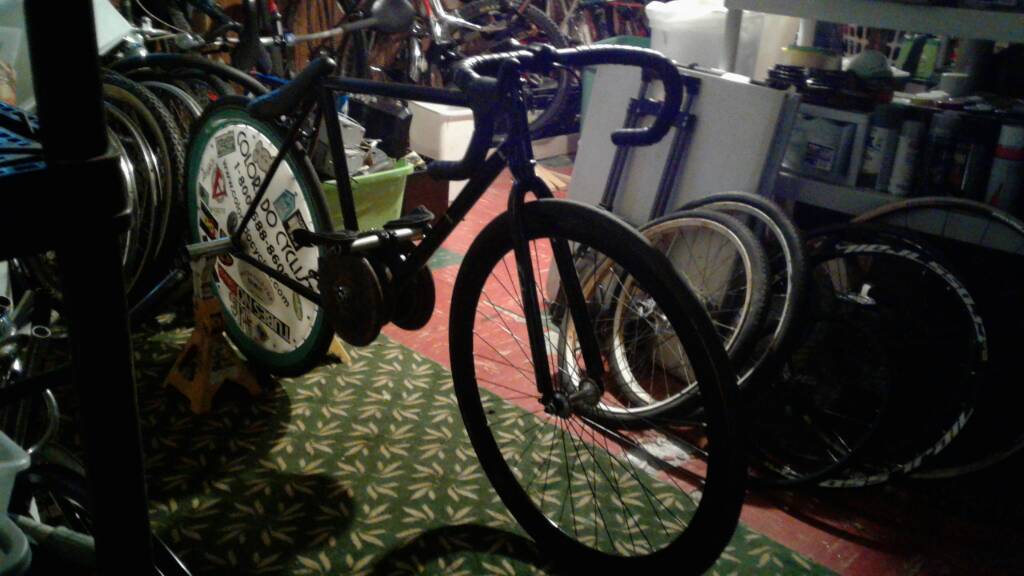




Last edited:
As a long-time gravity racer, I've found that off of a standing start, and on hills with minor grades (4-5%), the lighter vehicles tend to roll out better/faster. Where the weight really makes the difference is on steeper grades, and when speeds get higher. Around 35-45 mph (airspeed) seems to be the point when aerodynamics (or lack thereof) really starts making a difference, and the higher the weight, the higher the terminal velocity for a given grade is going to be. Basically, the weight just moves the threshold up finding the point when the frictional forces find equilibrium with the effect of gravity on the vehicle/rider.
Our mantra was, "Weight is nature's turbocharger." It doesn't necessarily get you out of the hole any faster, but on the top end, once you're "on boost", it can make quite a difference.
Science!
Also swapped out the bar for a narrower one. Should help with getting tucked.
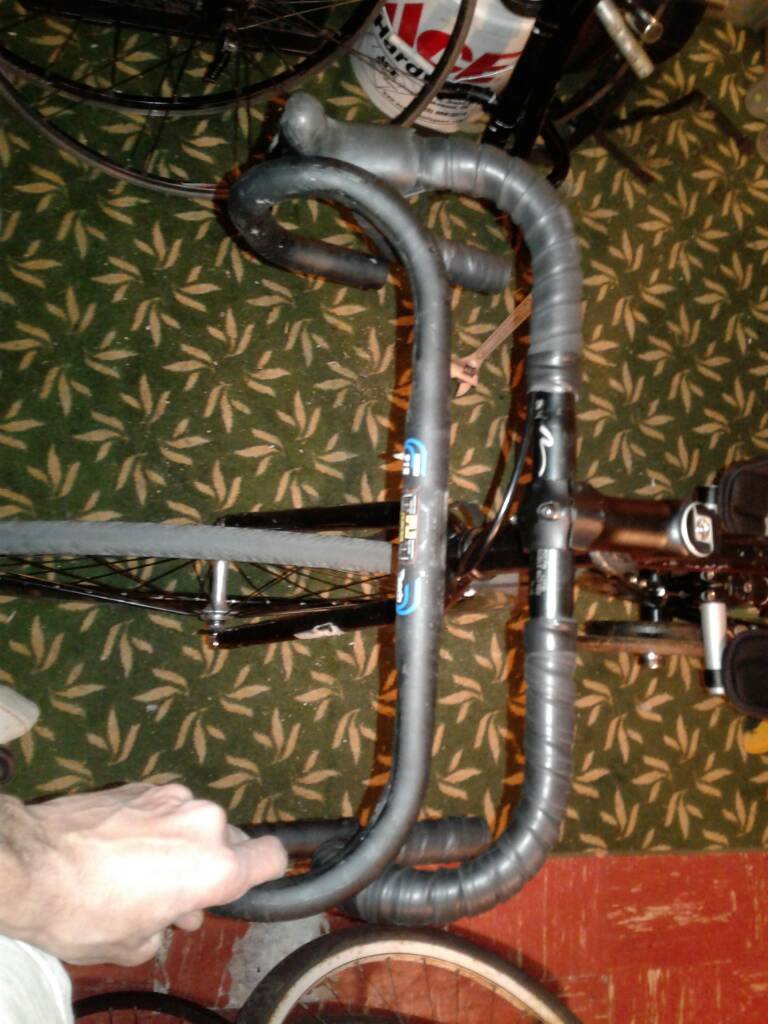

Making panels for the sides of the frame, want to give the bike more of a "body" so it doesnt just look like small frame tubes holing all these parts together. Plus, it gives me more space for logos, in fact, I think I am going to use our business logo on each side as my GF just made a couple vinyl stickers for me to put on my Jeep. I have put our logo and website on the back of the vehicle, just not the sides. They will be going on the sides of the chainless rig!


I also want to throw a little paint on the rusty weights, but it was supposed to snow last night into today... not sure I will be able to do that today!
Sent from my SM-G550T1 using Tapatalk
Sent from my SM-G550T1 using Tapatalk
14 hours left!


























































